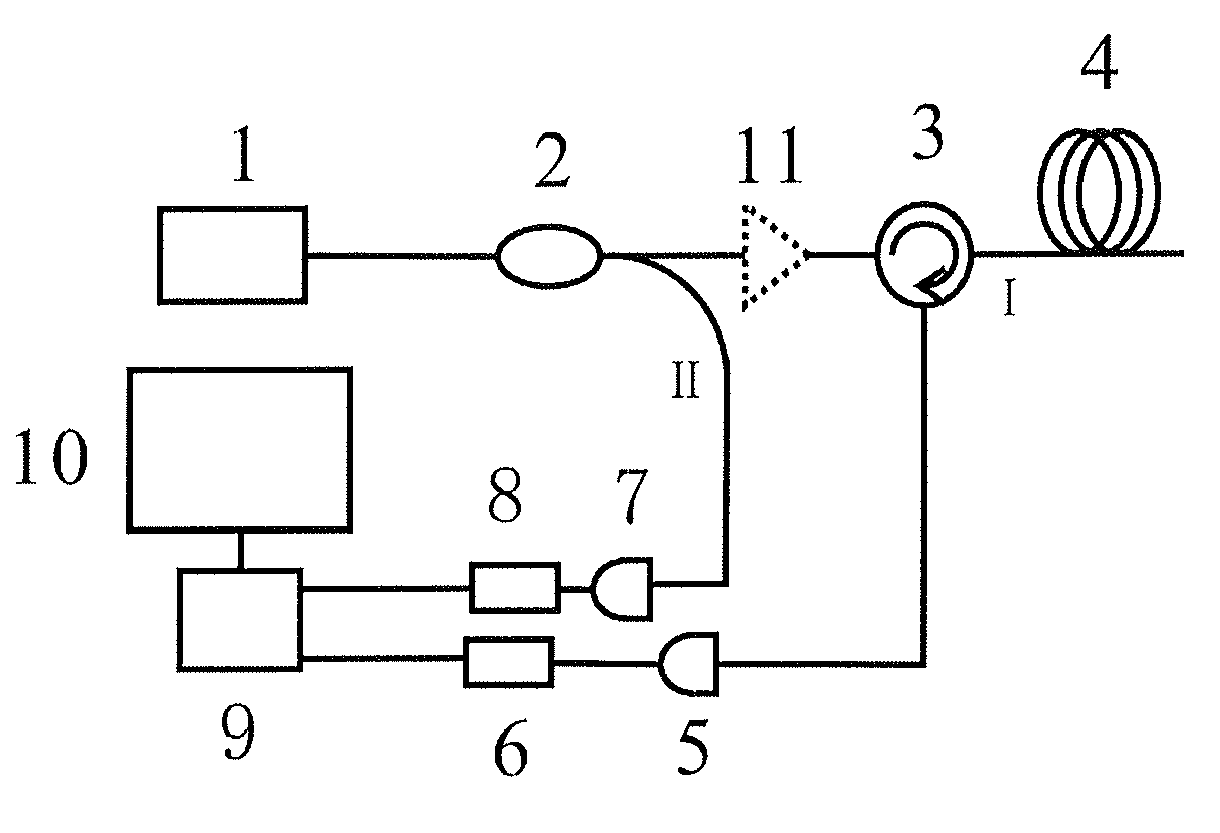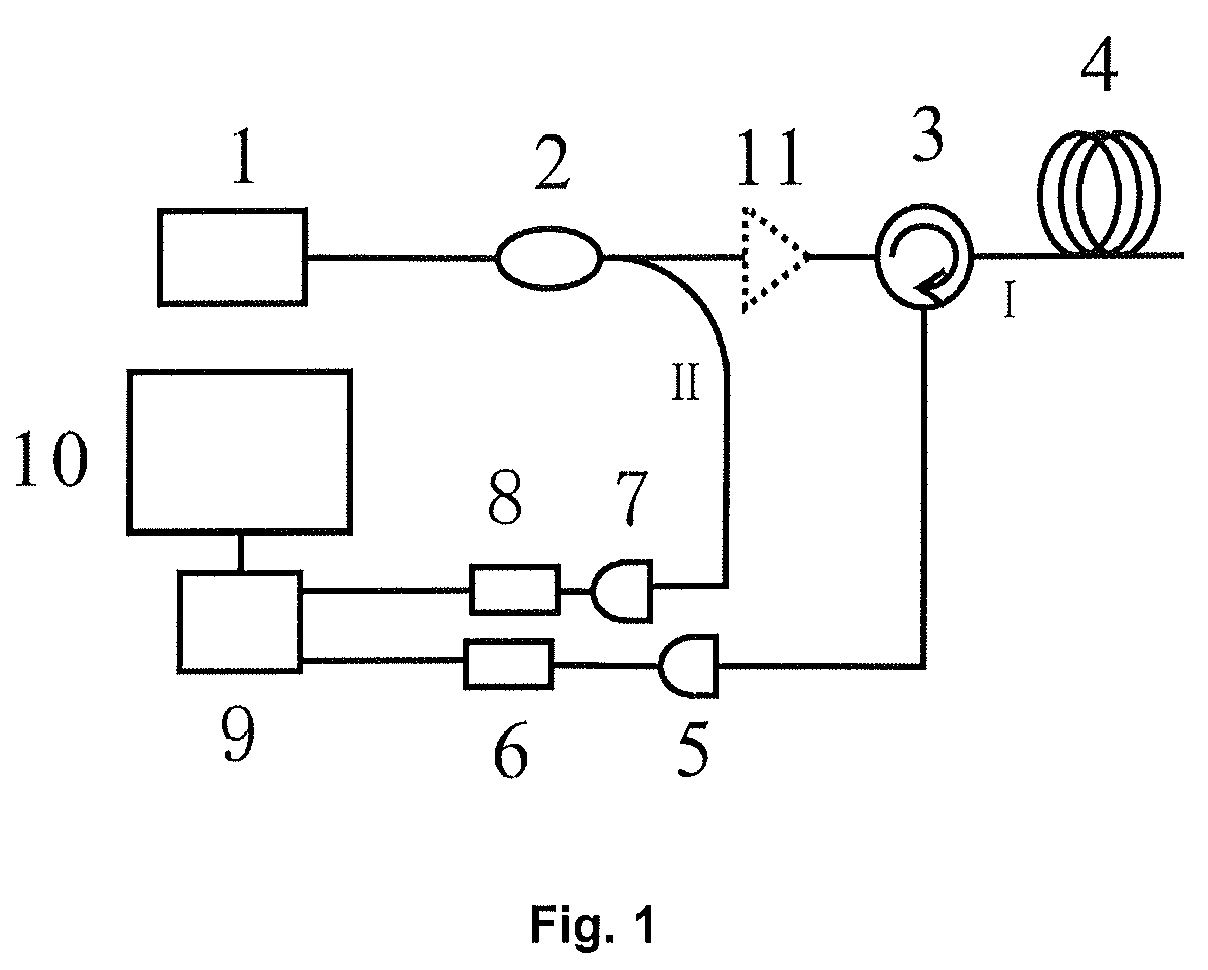Chaotic optical time domain reflectometer method and apparatus
a reflectometer and time domain technology, applied in the field of correlation optical time domain reflectometers, can solve the problems of reducing the resolution of pulse-based otdrs, unable to make full use of correlation technology advantages, and limited resolution, etc., to avoid disadvantages, simple structure, and high resolution
- Summary
- Abstract
- Description
- Claims
- Application Information
AI Technical Summary
Benefits of technology
Problems solved by technology
Method used
Image
Examples
embodiment one
[0047]FIG. 1 schematically depicts a chaotic OTDR according to the invention. The chaotic OTDR mainly comprises a chaotic laser transmitter 1, a fiber coupler 2, an optical circulator 3, two photodetectors 5, 7, two A / D converters 6, 8, a signal processing device 9 and a display device 10.
[0048]Further details of the chaotic laser transmitter 1 are explained below with reference to FIG. 2. The chaotic laser transmitter 1 is formed of a semiconductor laser 12, a fiber coupler 13, and a feedback section 14. The feedback section 14 is a digital reflector or an optical fiber with coated reflective film end or a fiber grating connected to a variable optical attenuator. In a semiconductor laser 12 with optical feedback, complex high dimensional chaotic output can be obtained by adjusting the controllable operational parameters of the feedback device 14. Alternatively, the feedback device 14 can be replaced by another semiconductor laser which is used as an injection laser, the chaotic las...
embodiment two
[0051]FIG. 1 also depicts the correlation method of the chaotic OTDR and further details are explained below. The chaotic laser signal emitted by the chaotic laser transmitter 1 is split into the probe signal I and the reference signal II. The back reflected probe signal I g(t) is a time-delayed version of the reference signal II f(x) and can be written as: g(t)=Kf(t−τ0). Here τ0 is the delay time and K is the loss factor. The back reflected probe signal I g(t) and the delayed reference signal II f(x−τ) are provided to the signal processing device 9 that realizes fault location of the test fiber by correlating two received signals. The result output is then displayed on a display device 10. The cross correlation function I(τ) between f(x) and g(t) is given by:
I(τ)=K∫−∞+∞f(t−τ)f(t−τ0)dt
[0052]From the position of peak of the correlation trace, the fault is located. FIG. 4 shows the cross-correlation traces, which are obtained by correlating the reference signal f(x) with the back-ref...
PUM
| Property | Measurement | Unit |
|---|---|---|
| wavelength | aaaaa | aaaaa |
| electrical signals | aaaaa | aaaaa |
| length | aaaaa | aaaaa |
Abstract
Description
Claims
Application Information
 Login to View More
Login to View More - R&D
- Intellectual Property
- Life Sciences
- Materials
- Tech Scout
- Unparalleled Data Quality
- Higher Quality Content
- 60% Fewer Hallucinations
Browse by: Latest US Patents, China's latest patents, Technical Efficacy Thesaurus, Application Domain, Technology Topic, Popular Technical Reports.
© 2025 PatSnap. All rights reserved.Legal|Privacy policy|Modern Slavery Act Transparency Statement|Sitemap|About US| Contact US: help@patsnap.com



